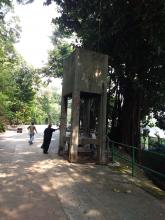British stone marker stating the 114'30" E boundary at sea dated 1902 [1902-2007]
Primary tabs
The marker is approximate. However for the accuracy of the then Royal Navy Engineers/Survayers I am pretty sure the stone used to sit exactly on the 114'30" E longitude.
Thanks for JW for this piece of Old News. Back in 2007 archeologists in Shenzhen had discover this stone marker at the tip of the Xichong (西沖)。 It was the boundary marker setup by the British for the seaward boundary concerning the taking (or lease, depends on how you look at it) of the New Territories.
The new clip mentioned this marker did not have any Chinese engravings on it and believed to be erected by the British on their own, without any liaison with the then Chinese Government. Typical British gunboat diplomacy strategy.
I have to admit I was unaware of this piece of news back in 2007 and wouldn't have notice it if JW did not bring it up.
I have no idea if the stone is now in a museum or still lying somewhere at the peninsula where it was found.
Best Regards,
T
Edit. JW forwarded another link to me earlier. This is the abstract of a paper by archaeologists. On the contrary this abstracts mentioned the stone marker is actually more or less the same as the two on Lantau, One of the faces has Chinese engravings. However this one was broken apart. The obelisk had collasped with the base broken. The abstract has one small paragragh in English. It also contains the engraving of all three marker stones. The three stones had been fixed by the same team. Maybe we should fix up some tags for these three markers?
Marker moved up the slope, at the top of a spur.
1902 THIS STONE IS IN LONGITUDE 114°30’0” E FIXED BY LIEUT AND COMR F.M.LEAKE R. N AND OFFICERS OF H.M.S. BRAMBLE〔2〕。FROM HERE THE BOUNDARY LINE EXTENDS DUE SOUTH UNTIL IT MEETS THE PARALLEL OF 22°9’ 0”N. NORTHWARD THE BOUNDARY FOLLOWS THE SOUTH SHORE OF MIRS BAY. 〔1〕


Comments
A bit more old news concerning the stone marker found in Shenzhe
Hi there,
This is a news clip by szlgnews.com. There are a few photos about the components of the broken marker.
T
http://www.szlgnews.com/lgnews/content/2007-11/07/content_1634183.htm
Stone Marker
T & JW, thanks for this. Interesting to see that the boundary ran along the shoreline of Mirs Bay. A bit like the pre-handover boundary running along the shore of parts of Lantau.
Regards, David
Re: Stone Marker
Hi David,m
If you fire up Google Earth, you should still be able to see a bourder line surrounding Hong Kong. That is fairly accurate. That was how I estimated the location of the marker. I have to move it a bit up the slope later as the engraving clearly mentioned how high.
The same clip was about the villagers handing over of what's left of the broken marker to Peng Chen Museum.
Best Regards,
T
Re:Boundary Stone Marker
In 2007, I was working in China and by one day, when I saw the news from china web site I felt very surprise - this news of course caught my eye balls because it relates to archaeology which is my favourite.
The stone marker in fact located at mountain cliff of certain height above sea level but in one day it dropped down to to the bottom of a erosion inlet of the sea coast and half submerged in sea water. The local villagers had already known such things that exisits there for long period. Prof Zhang of Shenzhen Archaelogical Institute finally found this stone with the aid of those villagers.
JW
Boundary markers in New Territories
Many years ago I wrote a thesis on the New Territories, with a chapter on boundaries. In the early 1970s I visited one of the boundary stones onn Lantao set up by the British mariners (Leake and officers from HMS Bramble) in 1902. The inscriptions were inaccurate and destined to complicate administration of the boundaries. At that stage no one cared. There is a photo of the stone in my thesis as presented for the degree but it doesn't appear in the editions of the subsequent book. For a brief discussion in said book, Unequal Treaty 1898-1997: China, Great Britain, and Hong Kong's New Territories (Hong Kong: Oxford University Press, 1998), see pp 153-4.